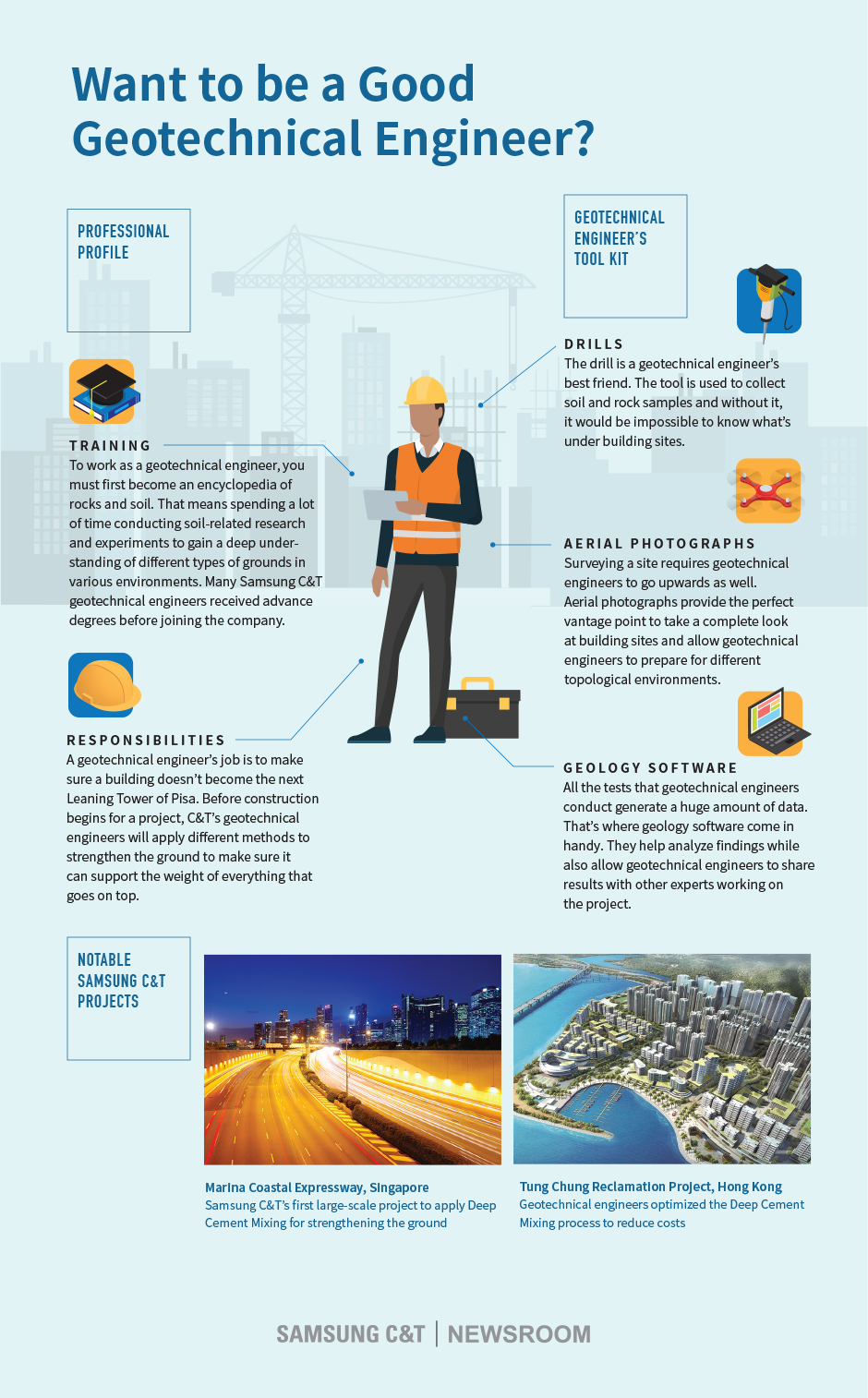What Does Geotheta Mean?
What Does Geotheta Mean?
Blog Article
The Greatest Guide To Geotheta
Table of ContentsThe Facts About Geotheta UncoveredThe Main Principles Of Geotheta The Best Strategy To Use For GeothetaThe Buzz on GeothetaHow Geotheta can Save You Time, Stress, and Money.

They conduct site investigations, accumulate examples, execute lab tests, and assess data to evaluate the suitability of the ground for building tasks - Engineer of Record. Based on their searchings for, geotechnical engineers supply referrals for structure layout, incline stability, retaining frameworks, and reduction of geotechnical hazards. They collaborate with other professionals, such as architects, structural designers, and building and construction teams, to make sure that geotechnical considerations are incorporated into the total job design and execution
By assessing the actions and homes of soil and rock, they can determine potential geotechnical dangers such as landslides, soil negotiation, or slope instability. Their proficiency aids prevent failings or accidents that can jeopardize lives and property. Here are some detailed tasks and obligations of a geotechnical designer: Site Examination: Geotechnical designers conduct website investigations to gather data on subsurface problems.
They analyze the information to understand the residential or commercial properties and behavior of the dirt and rock, including their toughness, permeability, compaction qualities, and groundwater problems. Geotechnical Evaluation and Layout: Geotechnical designers evaluate the data accumulated throughout website examinations to assess the stability and viability of the website for building and construction tasks. They execute geotechnical calculations and modeling to review variables such as birthing capability, settlement, slope security, side planet pressures, and groundwater flow.
Little Known Facts About Geotheta.
Foundation Design: Geotechnical engineers play an essential duty in designing structures that can securely support the desired structure. They assess the dirt problems and lots requirements to establish the proper structure kind, such as superficial foundations (e.g., footings), deep structures (e.g (https://anotepad.com/note/read/ew8kqmw7)., heaps), or specialized methods like soil improvement. They consider factors such as negotiation limits, bearing capacity, and soil-structure communication to establish optimal structure designs
They evaluate building and construction plans, screen site tasks, and carry out area evaluations to confirm that the style recommendations are followed. If unpredicted geotechnical problems occur, they examine the circumstance and supply suggestions for remediation or changes to the style. Danger Evaluation and Mitigation: Geotechnical engineers assess geotechnical dangers and dangers associated with the task site, such as landslides, liquefaction, or dirt erosion.

Cooperation and Interaction: Geotechnical designers function closely with other professionals entailed in a project, such as engineers, structural engineers, and construction groups. Efficient communication and collaboration are necessary to incorporate geotechnical considerations right into the overall job style and building and construction process. Geotechnical designers provide technical competence, solution queries, and make sure that geotechnical requirements are fulfilled.
Indicators on Geotheta You Need To Know
Below are some kinds of geotechnical designers: Structure Designer: Foundation engineers focus on developing and examining foundations for structures. They evaluate the soil conditions, tons demands, and site attributes to establish one of the most appropriate foundation type and style, such as shallow structures, deep structures, or specialized methods like pile foundations.
They examine the variables influencing slope security, such as dirt homes, groundwater conditions, and slope geometry, and create approaches to prevent incline failings and minimize threats. Earthquake Engineer: Quake designers focus on evaluating and developing frameworks to hold up against seismic pressures. They evaluate the seismic danger of a site, assess dirt liquefaction capacity, and create seismic style requirements to guarantee the safety and durability of structures throughout earthquakes.
They do area testing, collect examples, and examine the collected information to define the soil residential properties, geologic formations, and groundwater problems at a site. Geotechnical Instrumentation Engineer: Geotechnical instrumentation designers concentrate on monitoring and gauging the habits of dirt, rock, and structures. They mount and preserve instrumentation systems that keep an eye on elements such as soil negotiation, groundwater levels, slope motions, and architectural displacements to analyze performance and give very early cautions of possible problems.
The Geotheta Statements
They carry out examinations such as triaxial examinations, loan consolidation tests, direct shear examinations, and permeability examinations to collect data for geotechnical evaluation and style. Geosynthetics Designer: Geosynthetics engineers focus on the style and application of geosynthetic materials, such as geotextiles, geogrids, and geomembranes. They make use of these products to boost dirt security, reinforce slopes, provide drainage remedies, and control disintegration.
They often tend to be investigative people, which suggests they're intellectual, reflective, and curious. They are curious, methodical, logical, logical, and logical. Some of them are also social, meaning they're kind, generous, cooperative, person, caring, valuable, compassionate, tactful, and friendly - Consulting Engineer.
In the workplace environment, geotechnical designers utilize specialized software devices to do calculations, create layouts, and examine data. They prepare records, testimonial job specs, communicate with customers and team participants, and coordinate project tasks. The workplace setup offers a helpful environment for research study, analysis, and collaboration with other professionals involved in the task.
Geotheta Things To Know Before You Get This
They frequently see project sites to perform site examinations, evaluate geotechnical conditions, and gather data for evaluation. These check outs entail other traveling to different places, in some cases in remote or difficult terrains. Geotechnical designers might execute dirt tasting, conduct tests, and monitor building and construction tasks to make sure that the geotechnical facets of the project are being applied correctly.
Geotechnical engineers also function in specialized geotechnical research laboratories. Geotechnical research laboratory engineers work extensively in these atmospheres, taking care of screening tools, operating tools, and videotaping information.
Report this page